STREETLY,
STAFFORDSHIRE MEMORIES
(1936
- 1961)
THE PARISH HALL
STREETLY
DURING THE 1940s
by Chris Myers
|
THE
PARISH HALL, FOLEY ROAD, STREETLY
|
I have
already described – through the
eyes of my seven-year-old self – the
Home Guard Children's Christmas Party
which took place on a Saturday afternoon
just before Christmas, 1943. This was
held in the
Parish Hall in
Foley Road,
Streetly. The Parish Hall played
an important part in community life
during the war years and the following
post-war period. No doubt it had done so
throughout the 1920s and 1930s as well,
but those years passed before I became
conscious of the world around me at
about the outbreak of war in 1939. And my elder brother
and sister, who would have known it from
1931 onwards, never recounted any
particular stories about it. No doubt it
merely represented a part of their
normal, everyday existence as it did
later my own.
By the time I
reconnoitered
the area in 2018 in the hope of taking
some "after" photographs to
accompany the
"before" ones I have, the Hall had
totally disappeared, I found it was
impossible to establish exactly where it
had stood and the camera remained
unused. (As it did in some other areas as
well, not least
Little Aston
Park!) But the subsequent
appearance of further evidence and the
availability of modern images via Google
Street View mean that this omission can
be remedied
at least in part
and
illustrated.
It is
interesting for me - and something of a
surprise - to realise that the
existence of a building which meant so
much to so many people at that time is
now almost unknown to the majority of
21st century Streetly residents. For
that reason, I hope you will bear with
me if I tell you a bit of what I know
about it, and remember of it, just for
the record.
What I can tell you
is below, in three sections:
WHERE WAS IT AND WHAT
WAS IT LIKE?
WHAT WAS IT USED FOR?
ONE EVENT AT THE PARISH
HALL (out of so many)
|
|
WHERE WAS IT AND WHAT
WAS IT LIKE? |
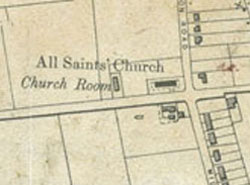 The Parish Hall
(or the Parish Room as my parents
insisted on calling it throughout my
childhood) was located in what is now
Foley Road
East, a few yards down from
All Saints
Church in the direction of the
Chester Road.
A 1920 Ordnance Survey map (left
- and no doubt
reflecting the layout of the area in
1918/1919) shows precisely where it was
- not immediately adjacent to the church
itself but perhaps 50 or 60 yards from
the latter's western boundary. (The
cartographer elected to use the
term "Church Room"). The Parish Hall
(or the Parish Room as my parents
insisted on calling it throughout my
childhood) was located in what is now
Foley Road
East, a few yards down from
All Saints
Church in the direction of the
Chester Road.
A 1920 Ordnance Survey map (left
- and no doubt
reflecting the layout of the area in
1918/1919) shows precisely where it was
- not immediately adjacent to the church
itself but perhaps 50 or 60 yards from
the latter's western boundary. (The
cartographer elected to use the
term "Church Room").
A 1926
aerial photograph (below,
left
- in which the Hall
itself is not to be seen as it is just
off the bottom border) shows that the
intervening area had, by then, gained a
substantial house set well back from the
road – no doubt the vicarage; and the
area between it and the Foley Road was
filled with a well cultivated garden
hidden from the road by a tall hedge.
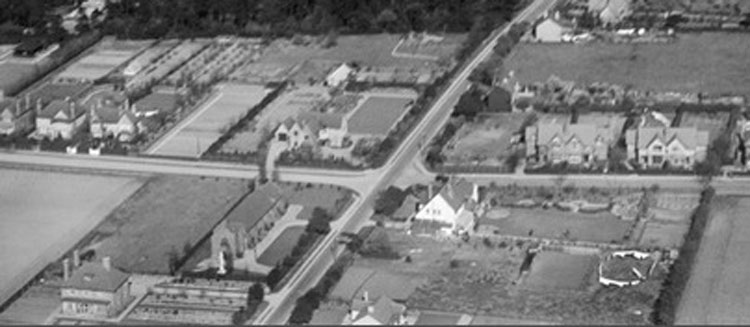 The
hedge is no doubt the reason why
I remember nothing about the
intervening land between the
Hall and the Church, apart from
the fact of something being
there which meant that the two buildings
did not directly adjoin. The
hedge is no doubt the reason why
I remember nothing about the
intervening land between the
Hall and the Church, apart from
the fact of something being
there which meant that the two buildings
did not directly adjoin.
From available information, we
can probably conclude that the
Parish Hall lay under all or
part of what is now
Foley Church
Close. Perhaps chunks of it
sometimes get dug up in the
gardens there, especially those
on the side of the road nearer
to the Church.
I do not know
the date of the Hall's building. It
clearly took place some time between
1908 (when the Church was built) and
around the end of the Great War, before
the Vicarage appeared. It may even have
been built at exactly the same time as
the Church, or just a year or two afterwards.
The Church would have been created to
fulfill the spiritual needs of a growing
local population; and the Hall would
have been there to benefit its social
life. There was certainly building going
on in the area during the Great War – I
know of at least one building in
Featherston
Road which dates from 1914/1915 - and
the 1920 map shows us how things had
already developed with at least five
houses already built in that road. (It seems as
though the impact of war at that time on
residential development was
less significant than during the events
of just 25 years later when everything
came to a halt for many years). And so
the Hall might have appeared as early as
1908 but must have been built at the
very latest by 1918/19. It would
therefore have stood, serving the
community for at least 50 or 60 years
and perhaps a bit longer, until
"progress" overwhelmed it.
The Hall
stood fairly close to
Foley Road,
set back perhaps 20 yards or so, and the
area at the front could therefore
accommodate a few cars. Perhaps that was
adequate. Or was there some sort of
overflow parking, down the left-hand
side? As time went on, well after I last
set eyes on it, the parking must have
been woefully inadequate and presumably
measures would have been taken if there
were space to accommodate them. But in
my time, I remember nothing at all of
that, nor of the need.
As you can
see from the map, the Hall stood at 90
degrees to the
Foley Road
and the entrance was of course at the
front, facing the road. At some stage in
its existence, another wall had been
built, right in front of the main
entrance door so that you accessed the
building around the side of that and
then turned sharp right to go through
the main door. Even as a child, this
arrangement looked a little strange to
me and I always put it down to the need,
which I witnessed in many other
buildings, for protection against
possible bomb blast. It probably had nothing to do with that,
however, but resulted from a
decision by the 1920's Church Wardens to
cut down the blast of cold air when
somebody opened the main door on a
winter evening!
Once one was
inside, it all looked vast, to
the eyes of a small child. An expanse of
polished parquet floor (together with
its smell of beeswax), a large number of
chairs arranged either around the edge,
below the windows with their blackout
curtains, or in rows,
depending on the event; and beyond them
the curtained stage extending across
much of the width of the building. On
the right-hand side of that, a door
leading, I think, to a kitchen; and a
similar door on the left leading to
goodness knows what - perhaps a
cloakroom or other facilities and the
mysterious area behind the stage.
|
I can
provide, from my own experience, just a
few glimpses of how it served the
community.
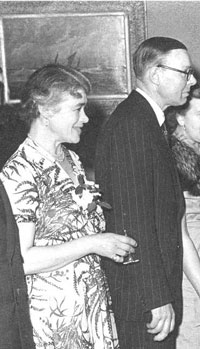 I have already described
one
of the parties I attended there. A
wonderful experience which I have never
forgotten and which, for some reason,
stuck in my mind more than other similar
events. There are likely to have been
other wartime Home Guard Christmas
parties which I would have attended, but
memories of them have gone. I went to
other parties there, in particular,
nearly every year, a
Dr. Barnado's
party. This was generously put on by
Mrs. Joan
Bretherton
(seen
right, with her husband Carl)
who lived in a large
house at the Little Aston end of
Hardwick Road:
she did much good work in the
community, including acting as
the local organiser for that
charity and, presumably out of her own
pocket, generously laid on a children's
party every year as a reward for those
children who had a collection box at
their homes. (I'm not sure if I ever
felt any twinge of guilt, but I should
have done as it was always my mother,
rather than I, who regularly put a spare
threepence or sixpence through the slot
in the roof of a little papier-mâché
house which was the collection box).
Games and film show and fun, just like
the Home Guard parties. There must also have
been the odd birthday party in the
Parish Hall, hosted by one or
other of my friends. And, just
for a few weeks, I went every
Sunday afternoon to Sunday
School, held in a circle of
chairs in the middle of the Hall
and run by an unknown lady.
The enthusiasm and interest were
short-lived and, to their credit
(or discredit?), my parents
never forced the issue. I have already described
one
of the parties I attended there. A
wonderful experience which I have never
forgotten and which, for some reason,
stuck in my mind more than other similar
events. There are likely to have been
other wartime Home Guard Christmas
parties which I would have attended, but
memories of them have gone. I went to
other parties there, in particular,
nearly every year, a
Dr. Barnado's
party. This was generously put on by
Mrs. Joan
Bretherton
(seen
right, with her husband Carl)
who lived in a large
house at the Little Aston end of
Hardwick Road:
she did much good work in the
community, including acting as
the local organiser for that
charity and, presumably out of her own
pocket, generously laid on a children's
party every year as a reward for those
children who had a collection box at
their homes. (I'm not sure if I ever
felt any twinge of guilt, but I should
have done as it was always my mother,
rather than I, who regularly put a spare
threepence or sixpence through the slot
in the roof of a little papier-mâché
house which was the collection box).
Games and film show and fun, just like
the Home Guard parties. There must also have
been the odd birthday party in the
Parish Hall, hosted by one or
other of my friends. And, just
for a few weeks, I went every
Sunday afternoon to Sunday
School, held in a circle of
chairs in the middle of the Hall
and run by an unknown lady.
The enthusiasm and interest were
short-lived and, to their credit
(or discredit?), my parents
never forced the issue.
Adult events
were not normally attended by us
children. But of course they occurred –
all the normal things that occupied and
diverted the minds of adults at that
time: whist drives, dances, amateur dramatics, choral activities, political
meetings, private gatherings ........
anything where the community wanted to
come together and needed a venue for
which the alternatives (which can only
have included
All Saints
and the
Methodist Church, the
Hardwick Arms
and the
Parson & Clerk,
the
Golf Club and whatever
facilities the local schools
possessed) were unsuitable for
other than specialist tastes.
 One
of the most serious events was
the night when the Hall hosted
the very first meeting of the
local Home Guard. Those who had
put their names forward in the
days following
Anthony Eden's
broadcast of Tuesday, May 14th
1940 were summoned to attend it
and receive further information
as to what was to be done at a
moment when invasion, previously
unthinkable, had almost
overnight become a real threat -
a probability even. This is the
invitation to this meeting
received by my father and my
elder brother, both anxious "to
do their bit". Which they did,
over the following years. One
of the most serious events was
the night when the Hall hosted
the very first meeting of the
local Home Guard. Those who had
put their names forward in the
days following
Anthony Eden's
broadcast of Tuesday, May 14th
1940 were summoned to attend it
and receive further information
as to what was to be done at a
moment when invasion, previously
unthinkable, had almost
overnight become a real threat -
a probability even. This is the
invitation to this meeting
received by my father and my
elder brother, both anxious "to
do their bit". Which they did,
over the following years.
Because
of my age I only caught a very
occasional glimpse of more
grown-up events. For example, a
vision of my sister in Girl
Guide uniform kneeling with a
friend up on the stage in front
of a pyramid of sticks,
pretending to light the bonfire
- and succeeding because the
pyramid rapidly glowed red. Not
very convincing, really, because
even I knew that it was only a
red bulb which had been switched
on - and I was also an expert on
PROPER, serious bonfires and so
knew about these things. But you
entered into the spirit and
clapped, like everyone else. Of
course you did.
And there
were plays and concerts and displays
which were suitable for youngsters and
you sat through them with varying
degrees of involvement or boredom. Once
I went to some dancing event where the
activity took place in the middle of the
floor rather than up on the stage. A
group of ladies were all dressed in
long, shiny, pink dresses and were
flitting around. I didn't know most of
them but I did recognise, to my great
surprise, one lady who lived on the
opposite side of the road to us on the
Chester Road.
She was quite ancient, just like my
parents. She must have been at least 40.
And there she was, circling with others
around the floor, one arm outstretched
above her and carrying a flower, the
other arm trailing down behind her, her
face one of intense concentration as she
tried to appear graceful and artistic;
and then all of them moving inwards,
their upstretched arms coming together
to form a posy of flowers at the peak of
the pyramid. Great applause. Bloomin'
daft, I remember feeling at the time:
why do grown-ups have to make such fools
of themselves sometimes, to act so
unnaturally so that they become
different people? A bit like
they do at Church
which is one of the reasons I hate
going..... But of course I clapped, like
everyone else.
I had just
one experience of the Hall's stage
myself. It was one of the nastiest
experiences of my young life. I was five
and had not long started school, at
Sandwell.
We were told that we were to perform in
public. I can't remember whether it was
a sort of dance or a gymnastics display. A group
of us was ushered on to the stage to do
our thing. The audience below us
stretched out, down the entire length of
the Hall. Everyone was looking just at
me. I knew that for certain. There
followed an excruciating five or ten
minutes which I spent pressing myself as
close as I could to the side curtains
and keeping as many people in front of
me as I could. But all the time I knew
that I could not hide completely. It was
truly ghastly. Roars of applause as I
scuttled off the stage with all the
others. That was little compensation.
The thought of that experience has never
left me, kept me as far as possible from
stages of any kind and is no doubt the
only reason why I never became the
second Laurence Olivier (much as I later
idolised him in 1944 as he led us to victory
at the Sutton
"Empress" cinema over the foppish French in "Henry V").
Others had
far fewer inhibitions about appearing on
the Hall's stage. Dramatic performances
were given by local people. A lady by
the name of
Mrs. Dean was one of the leading
lights: she lived in
Manor Road.
Politicians appeared, especially around
election time.
Duncan Sandys
and Peter
Thorneycroft, and, I think,
Christopher
Soames. The latter had married
Churchill's daughter Mary and became the
father of Nicholas (now
Lord Soames).
All three of them later occupied some of
the highest Offices of State in
Conservative governments. I was taken to
a couple of such meetings by my parents
in the immediate postwar years and on
one occasion with a female contemporary.
One of the politicians observed in his
speech how gratifying it was to note
members of the younger generation in
attendance. This comment flew far over
the head of my companion who by that
stage was wholly oblivious and was
concentrating on her colouring-in book.
But I noticed it and it encouraged me in
my efforts to look intelligent and
attentive to whatever he was banging on
about. Which was gobbledygook to me of
course - I understood little at the time
and remember even less now. But the
message would certainly have been what
my parents and most of their friends
wanted to hear:
"Times are unutterly
grim, five years after the war. Did we
really win it? Shortages everywhere,
rationing still with us, permits needed
for everything, the Government
wasting money right, left and centre - just look at the
Groundnuts Project! ...We need Winston
back...."
From that message came a
distant hope, specifically for me - full
availability of new Dinky Toys and sweets
coming off the ration. It took a long
time for it to be fulfilled.
It seems
astonishing to me that, as far as I am
aware, no image of the Parish Hall
during its long life seems to have come
to light. I can't believe that none
exist and that cannot be the case; but it seems that nothing has so
far surfaced. The only ones I have ever
seen are those which appear below. |
JUST
ONE EVENT AT THE PARISH
HALL
(OUT OF SO MANY) |
TThe following
images depict a
particular event, out of the thousands
which must have occurred
throughout the life of the
building. It is a children's
gathering, of the sort which I have
described above. I suppose that it COULD
be a record of the
Home Guard children's party which I
attended in December 1943 and have remembered
ever since. I cannot be sure. And I have to be honest and
say that it may well not be: it is more
likely to show an earlier event, perhaps
in 1941 or 1942. It is still definitely
wartime and perhaps it is another,
earlier, Home Guard party; or perhaps
a different event, also held for the benefit of
local children.
Most of the
images in this
section come from
the camera of Mr.
Bill Cutler who had
the foresight to
record some aspects
of Streetly life
during the war years
and the immediate
postwar years. Their
quality is dictated
by the fact that
they are stills
taken from 9.5mm
cine film. Whether
they are pin-sharp
or not, we are
indeed lucky to have
them.
In the
first sequence we see the
arrival of a few of those attending the
event, to
enjoy what it has to offer or to help to
make it happen - or both. |
The Arrivals
The
following
images show us various Streetly
people arriving for the event.
We are in the forecourt of the
Parish Hall.
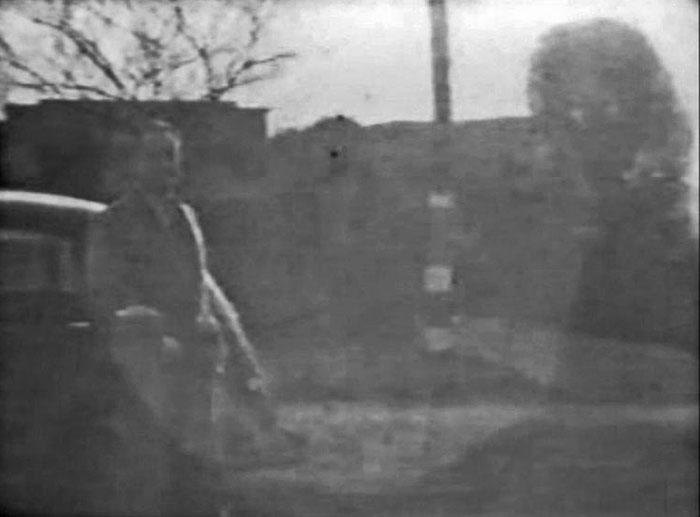
This first
image, fuzzy and unsatisfactory
as it is (because the camera is
facing the wintry sun) has been
included because it give us a
glimpse of the view out across
Foley
Road.
A man has appeared
escorting his child. Perhaps it
is his car we can see parked
behind him – a black Flying Standard.
He is starting to walk towards
us.
Another man in the foreground is
greeting him.
In the
background, on the edge of the
far side of the road, is a
telegraph pole with white
stripes painted around it to
assist motorists as they grope
their way along the road after
dark with
only the glimmer of masked
headlights to assist them.
Beyond it are a hedge and open
fields. There seems to be a
large building of some sort in
the distance to the left: its
outline here suggests something
substantial, and industrial
even. But it can only be the
outline of a house which
appeared between 1920 and 1926 (just after the 1920 map
and before the 1926 aerial
photograph shown above) and is
also shown on this 1940s map of
Foley Road, marked with a
red
arrow
(below)).
I have no recollection of it.
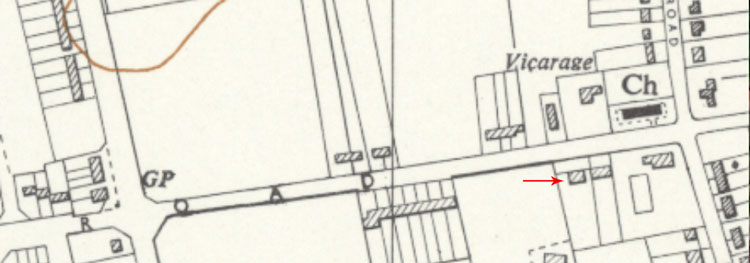
More people
arrive.
Another man is escorting an
eight or nine-year-old boy. And
a lady in a felt hat, perhaps
her husband or a grown-up son at
her side. Again we can see a
car parked behind them on the
road. We shall get a better view
of that later.
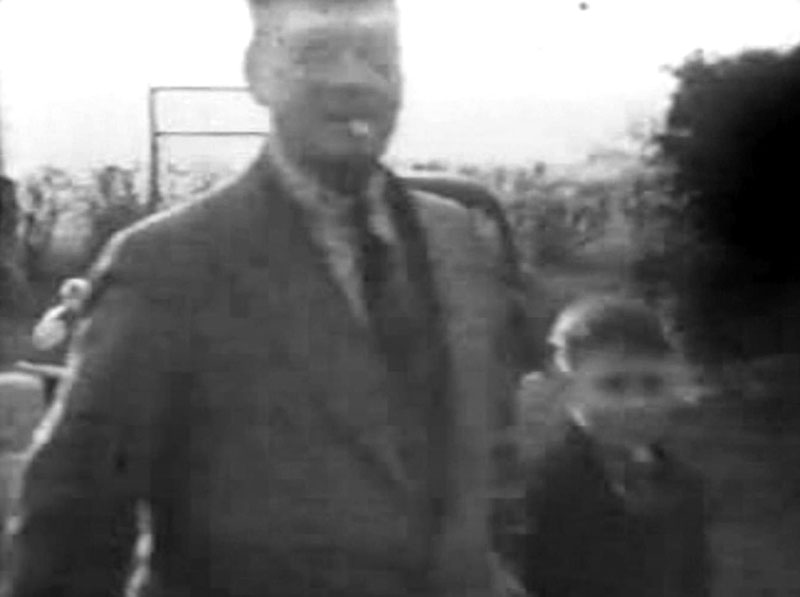 |
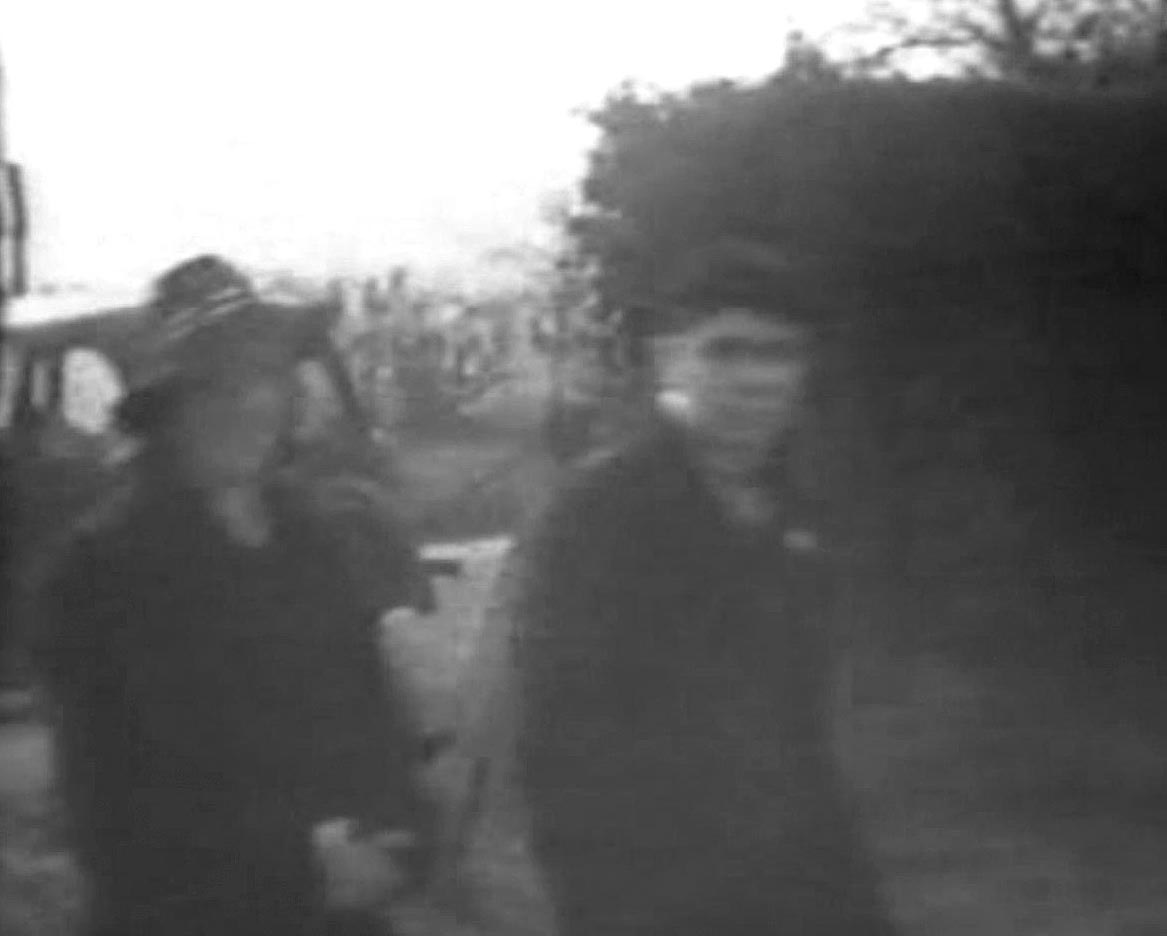 |
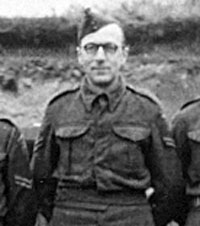
Then,
looking towards the Hall, two
men
(below). The one in the spectacles
might be
Joe
Perry
(left) who was a comrade
of my father in the Home Guard
and lived with his wife,
Meta, on the
Chester Road, between the
ruins of
Manor
Farm close to
Bridle Lane and the
junction of what is now called
Foley
Road West.
In the Home Guard one of his
duties was to act as Mess
Steward, almost certainly at
Company HQ, located at
"The
Greylands", a requisitioned
house in
Middleton Road
near to
the junction with
Manor Road.
Mr. Perry was a born entertainer
and was often to be seen at
social events, performing as a
comedian and pianist.
Perhaps he is going to do a
performance at this one, even
acting as Master of Ceremonies.
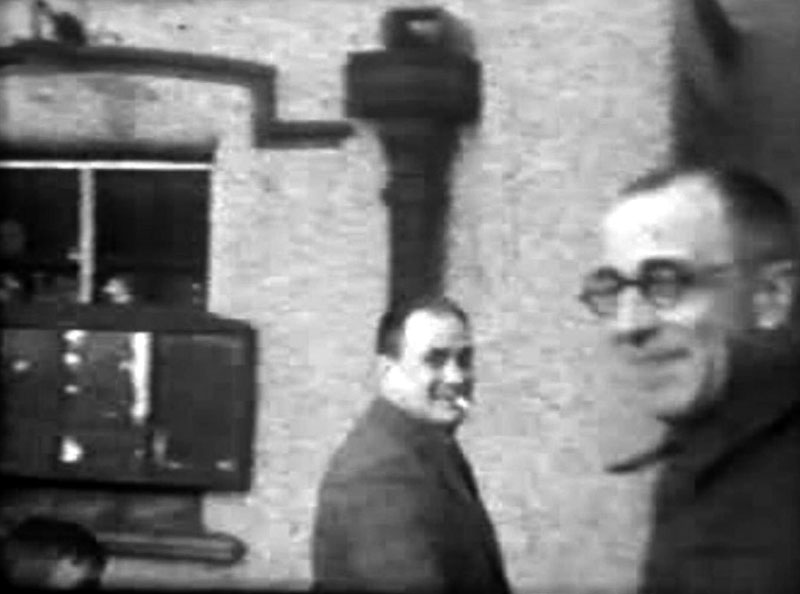
|
And then what
soon happens inside the Hall.
Inside the Hall
We'll now move inside the Hall
to see what is about to happen.
This stage is well lit and
children are going through their
paces. A little girl dances and
twirls.
At the end of her
performance she moves off the
stage to the left. And gives us
a final move before she
disappears.
Then
we see what is probably the full
cast, apparently singing for our
benefit.
Well done, young ballerina and
the other youngsters. You're all
far braver than I. (And anyway,
my mum would never have bought
me a frilly tutu like that).
These
are just glimpses of what has
been going on. Is it a school
concert? Or some entertainment
in the middle of a party? |
|
When
it finally comes to an end, the
participants leave the Hall and go back
to their homes, most of them on foot or
bike and a few by car - if they are
lucky enough to own one and to have an
essential user's petrol ration with
which to fuel it.
|
Departures
Our
photographer is back outside to
record the audience and helpers
leaving the event. In the
background are the only images I
have seen of the front of the
Parish Hall with its strange
entrance – the main doors
obscured by a brick vestibule
around which the entrance is on
the right. A noticeboard faces
us with no notices on it.
Two Home Guard blokes are
discussing something, just by
the entrance. They are in
uniform. Someone's Rover is
parked just in front of us.
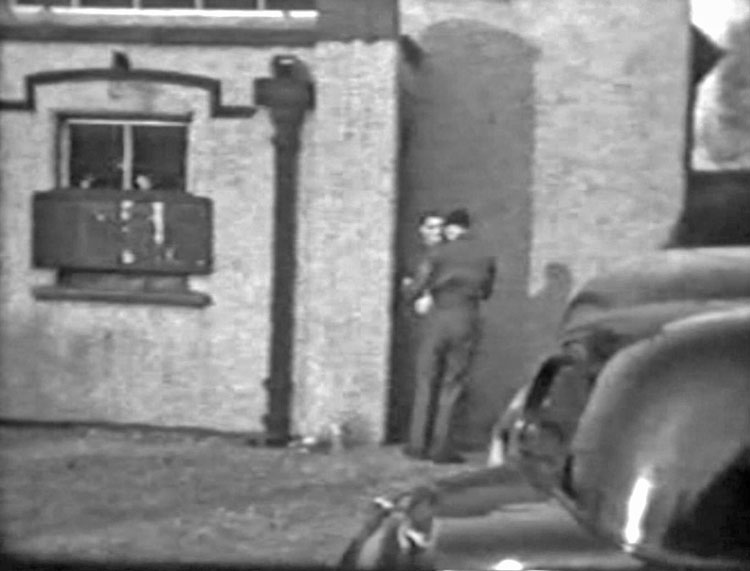
A man and his ten or
eleven-year-old son, in
school cap and raincoat, have
squeezed past them and now walk
away.
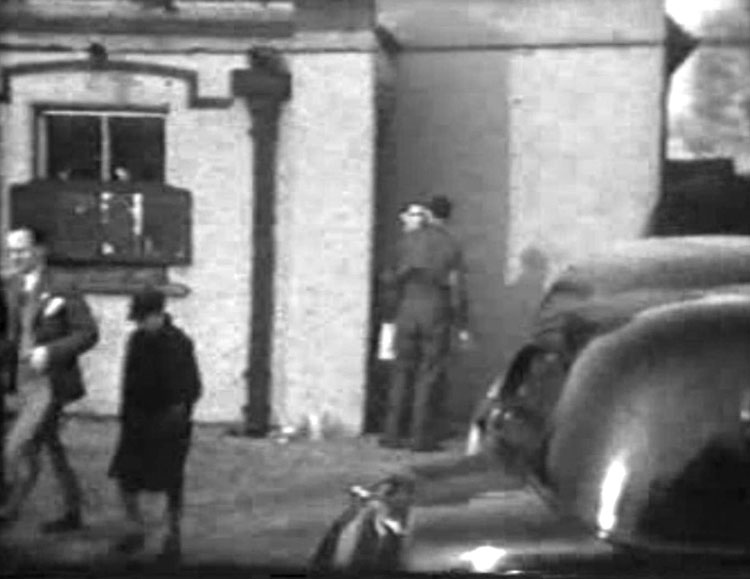
We can see that the Home
Guard man is wearing an HG
armband on his sleeve. This is
a throwback to the time in 1940
when full uniform was in short
supply and was still being
issued - a time now largely
passed by, but the armband
remains in evidence in these
still relatively early days of
the war.
 A
much younger boy and his father
have now emerged from the Hall and
are walking towards us, past the
parked Ford Prefect Coupé. The man is
Mr.
Carr, another member of
the Home Guard although he is
not in uniform this
afternoon. Mr.
Carr is a Sergeant, which
probably means that he served in the
Great War; and later he will
become an officer. A
much younger boy and his father
have now emerged from the Hall and
are walking towards us, past the
parked Ford Prefect Coupé. The man is
Mr.
Carr, another member of
the Home Guard although he is
not in uniform this
afternoon. Mr.
Carr is a Sergeant, which
probably means that he served in the
Great War; and later he will
become an officer.
Mr.
Carr is looking down at his
child and saying something.
Perhaps:
"Look, somebody
is taking a photograph. It's
Mr.
Cutler, you know him. And
you know what to do, just look
up at the camera and smile."
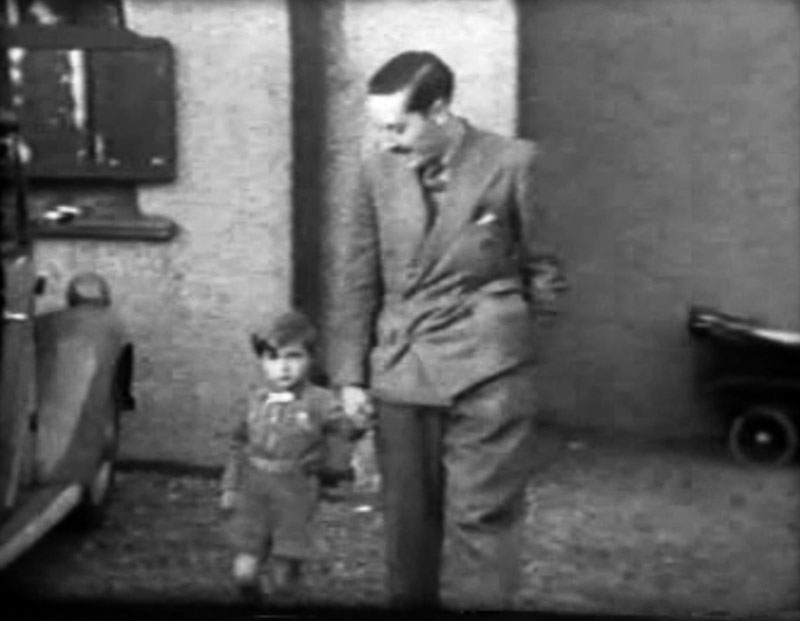
"Like
I'm doing".
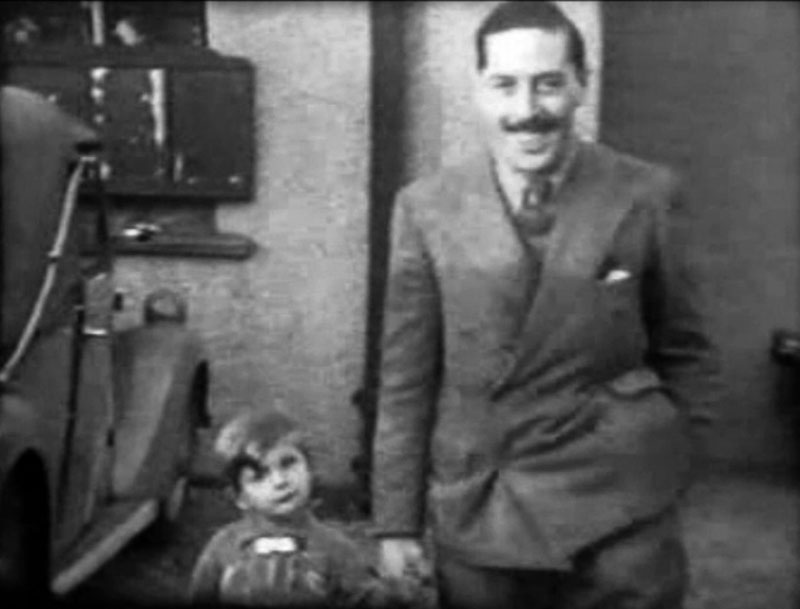
The
child, however is not so
certain. He will certainly know
Mr. Cutler, but when you are
only three or four you tend to
view new circumstances with a
degree of caution. And a lot has
been happening this afternoon
already. It has been quite
bewildering.
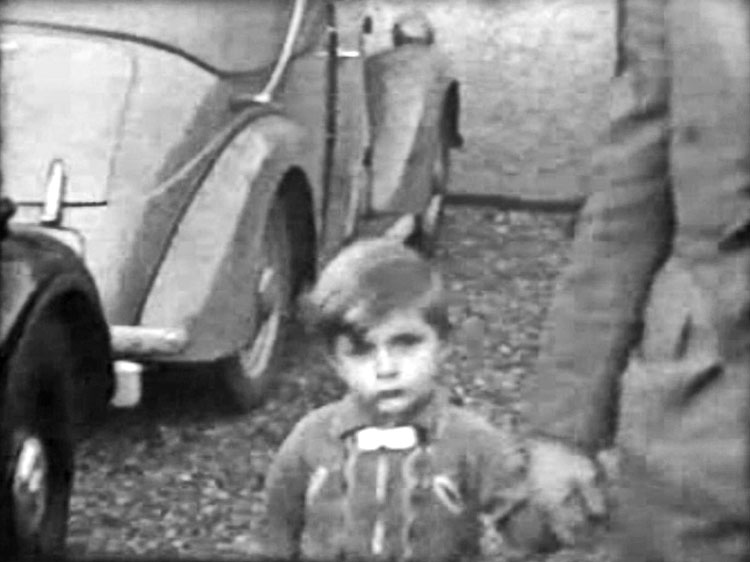
Another man emerges from the
Hall. He is carrying something.
He hoists it on his shoulder and
comes closer to the camera.
Whatever he is carrying, it is
well wrapped up. In fact it is a
Lewis
machine gun. And the man
carrying it is in Home Guard
uniform. His weapon has no doubt
been on display during the
afternoon. Perhaps he has been
explaining to the older children
how it works.
He comes closer towards us.
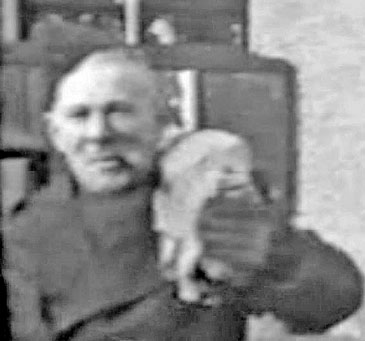
The guardian of
this bit of lethal weaponry is
very likely to be
Mr.
Ralph who lives in
Middleton Road.
Mr.
Ralph is known for his
expertise with guns such as
this. In fact he has his own
anti-aircraft installation on
open land between
Wood
Lane and
Hardwick Road as this
1920 map, marked up in 1940,
(below)
indicates. The location is
noted as "M.G"
and is adjacent to the HQ of
No.3
Platoon
in
Little Hardwick Road.
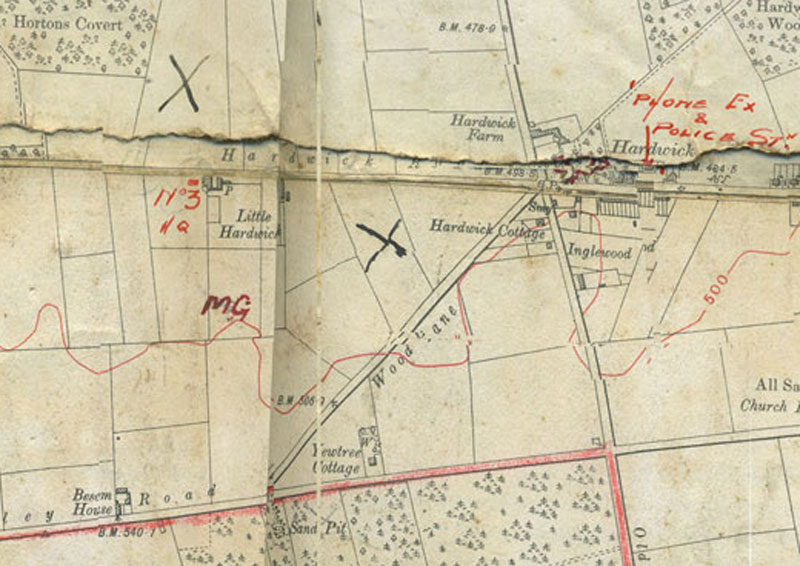
Some images also
survive of this defensive
position and Mr. Ralph can be
seen training some of his
colleagues in the use of the
gun. Regrettably we shall never
know whether it was ever fired
in anger.
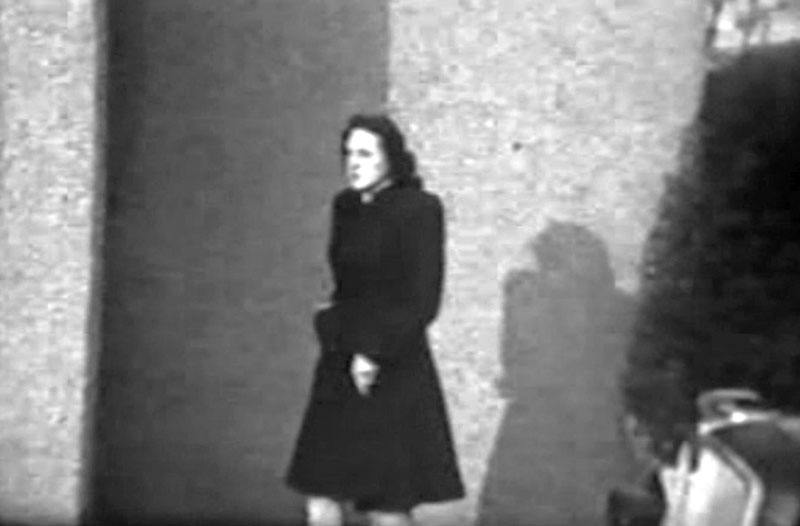 Back
at the Hall,
an unknown lady also emerges
into the wintry sunshine. Is she a mother
of one of the children? Or has
she been helping with the
arrangements or the catering? Or
even both? Back
at the Hall,
an unknown lady also emerges
into the wintry sunshine. Is she a mother
of one of the children? Or has
she been helping with the
arrangements or the catering? Or
even both?
We
now move to the pavement and
look down Foley
Road in the direction of
Chester Road. The car we
saw previously is still parked
at the roadside, with the
obligatory mask on its one
operational headlight and blobs
of white paint on its front
mud wings. It's an Austin 10
Cambridge. By the
side of it two men are in
discussion. The man on the right
is holding forth on an unknown
subject at which we can only
guess. The progress of the
German invasion of Russia? The Americans'
entry into the war, at long last? Last week's air
raid? Or something mundane such
as the price of potatoes or a
further reduction in the tiny
meat ration?
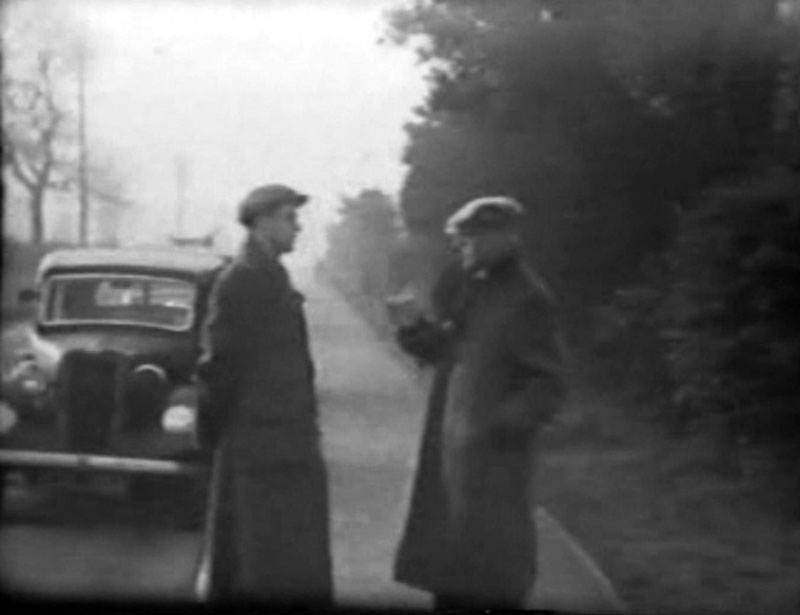
Whatever it is, he has
opinions. While he is talking a
car, perhaps a Morris, comes up the road and
overtakes the parked vehicle
before carrying on towards
Streetly Village. And a
man has just walked past the
pair.
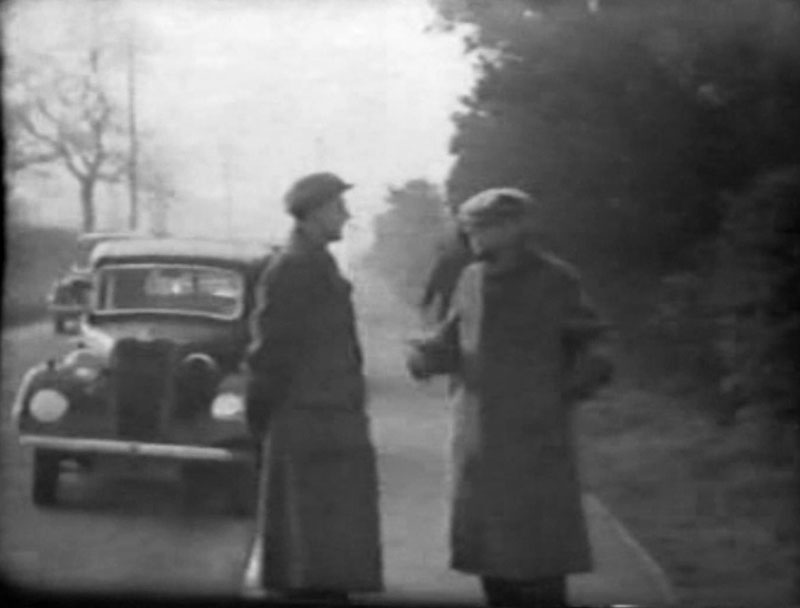
The man on the left ventures
an opinion.
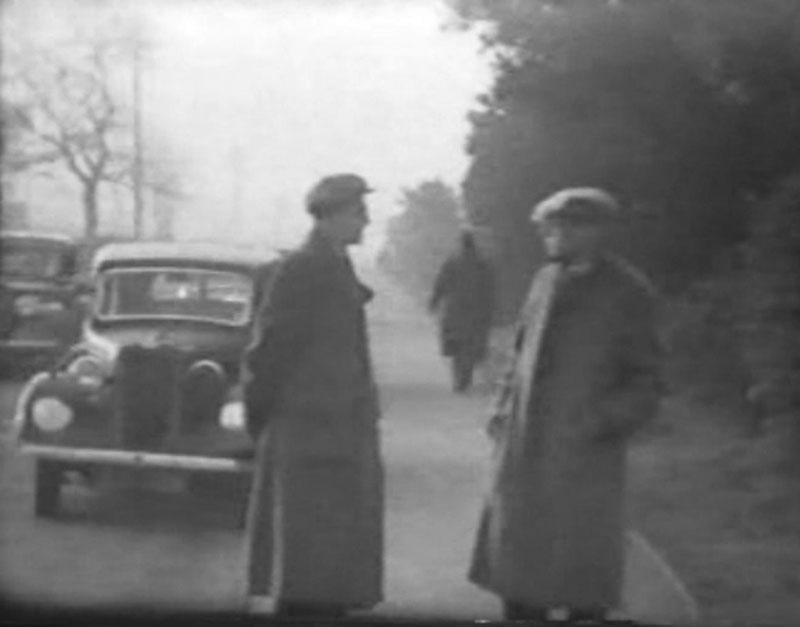
The third man has walked past this pair
on his way down towards the
Chester Road. Has he been
to the event as well? He turns
to look back at us. Is he
checking on the state of the
discussion? That seems to be
nearly over. Or is he having a
final look at the cameraman
before he continues on his way
home?
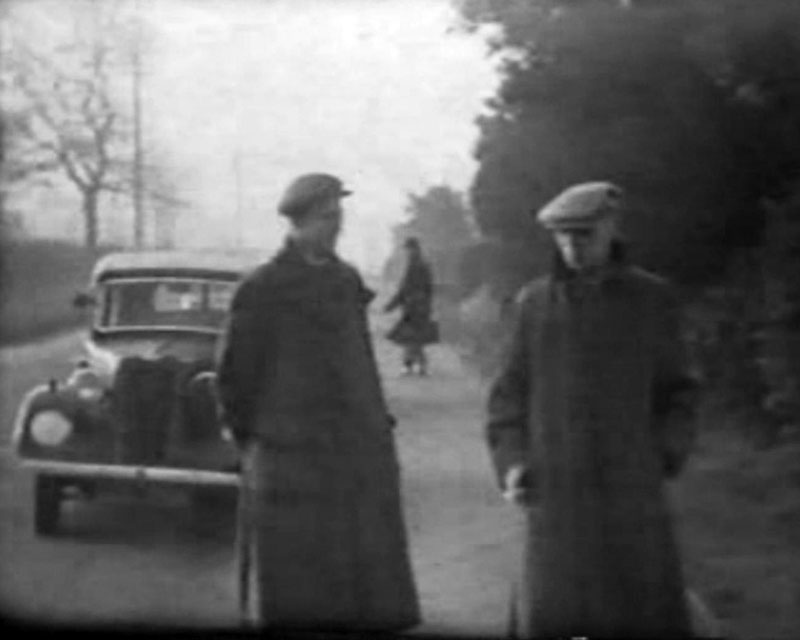
He will walk down the hill
past a handful of 1920s/1930s
houses; but mainly
open fields stretching away on each side, behind
their tall hedges. At the crossroads he
will not immediately turn left
or right because there are no
houses in either direction for
several hundred yards on this
side of the Chester Road, just
farmland. So he will cross over
the road where he has the choice
of going off to his home to the
left or to the right, where
there ARE houses, or of carrying
on along
Foley
Road towards further
homes including a couple of
short cul-de-sacs,
Egerton Road and
Blackwood Road.
And then, toast-and-dripping by
the fireside on this winter
afternoon? The wireless on as
the light outside fades. Nearly
time to put the blackout
shutters up and close the
curtains. Sunday tomorrow. A day
off. Apart from the Home
Guard parade in the
morning, or giving the vegetable
patch its winter dig... |
|
The
moment passes.
As does the Hall itself a
few decades later. And with it, as the
years go by, the small community of an
earlier Streetly and everyone who knew it in
those faraway days. Apart perhaps from a
few of the children who appear in these
images and who, like me, might still
remember a tiny bit of it in old age. Just a
glimpse, here and there..... |
**********
POSTSCRIPT
Things have changed,
just a little, over the
ensuing 80 years.
|
**********
|
ACKNOWLEDGEMENTS
Grateful acknowledgement
is made to the late Bill Cutler for having
had the foresight to create a record of
aspects of Streetly life in the 1940s; and
also to Kate Cutler for making them
available to staffshomeguard and generously permitting their
use in this website.
Further
acknowledgement is made to members of the Streetly
History Facebook group and the Birmingham History
Forum for providing useful information; and
to other sources including The Library of Scotland,
Google Street View and Britain from Above.
Images from the
Parish Hall and the anti-aircraft
installation are © Kate Cutler
2023
All
ttext and
other images are © The Myers Family 2023
This family
and local history page is hosted by
www.staffshomeguard.co.uk
(The Home Guard of Great Britain, 1940-1944) |
|
INDEX
Home Guard of
Great Britain website |
 |
INDEX
Streetly and Family Memories 1936-61
|
L8U Jan 2023
© The Myers
Family 2023


|